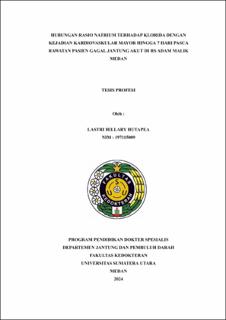| dc.contributor.advisor | Hasan, Refli | |
| dc.contributor.advisor | Haykal, Teuku Bob | |
| dc.contributor.author | Hutapea, Lastri Hillary | |
| dc.date.accessioned | 2025-03-27T03:31:51Z | |
| dc.date.available | 2025-03-27T03:31:51Z | |
| dc.date.issued | 2024 | |
| dc.identifier.uri | https://repositori.usu.ac.id/handle/123456789/102611 | |
| dc.description.abstract | Objective:
Acute heart failure (AHF) can be defined as a critical medical condition resulting
from the heart's inability to pump blood efficiently. A key aspect in the
management of AHF is predicting major adverse cardiovascular events (MACEs)
during the "acute phase," with monitoring laboratory findings considered as a
potential prognostic tool. This study aims to determine the relationship between
the sodium/chloride (Na/Cl) ratio and the risk of MACEs in AHF patients during
the first 7 days of hospitalization.
Methods:
This observational, single-center, cross-sectional study was conducted at Adam
Malik Hospital, Medan, Indonesia, from May to October 2024. The researchers
included AHF patients with complete Na/Cl ratio data (with a cut-off of 1.3) at
initial presentation, who were subsequently hospitalized for at least 7 days to
evaluate the risk of MACEs. Statistical analysis was performed using SPSS
version 24.0.
Results:
We included a total of 50 AHF patients (70.0% male) with a mean age of 58.98 ±
11.42 years into the final analysis, with 80.0% were diagnosed with acute de novo
heart failure (ADHF). A higher proportion of MACEs was observed in the group
with an elevated Na/Cl ratio (76.3% vs 33.3%; P=0.012). However, no such
association was found when analyzing sodium or chloride levels individually, nor
was there any correlation with in-hospital mortality (P>0.05). Interestingly,
higher Na/Cl ratios and lower chloride levels were found in the MACE group
(P<0.05). Diagnostic performance analysis showed that the Na/Cl ratio had a
sensitivity of 63.6% and specificity of 64.7%, respectively.
Conclusion:
The Na/Cl ratio is a reasonably reliable parameter for predicting MACEs, as an
increase in this metric indicates a higher risk of MACEs | en_US |
| dc.language.iso | id | en_US |
| dc.publisher | Universitas Sumatera Utara | en_US |
| dc.subject | Acute heart failure | en_US |
| dc.subject | Major cardiovascular events | en_US |
| dc.subject | Chloride | en_US |
| dc.subject | Sodium | en_US |
| dc.subject | Sodium-chloride ratio | en_US |
| dc.title | Rasio Natrium terhadap Klorida dengan Kejadian Kardiovaskular Mayor Hingga 7 Hari Pasca Rawatan Pasien Gagal Jantung Akut Di Rs Adam Malik Medan | en_US |
| dc.title.alternative | The Relationship Between Sodium To Chloride Ratio With 7 Days of Major Cardiovascular Events Of Acute Heart Failure Patient In Haji Adam Malik General Hospital | en_US |
| dc.type | Thesis | en_US |
| dc.identifier.nim | NIM197115009 | |
| dc.identifier.nidn | NIDN0003046101 | |
| dc.identifier.nidn | NIDN0020078502 | |
| dc.identifier.kodeprodi | KODEPRODI11715#Ilmu Penyakit Jantung dan Pembuluh Darah | |
| dc.description.pages | 100 Pages | en_US |
| dc.description.type | Tesis Magister | en_US |
| dc.subject.sdgs | SDGs 3. Good Health And Well Being | en_US |


